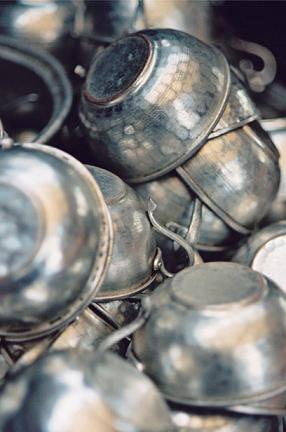


Greg had meticulously detailed lists of the dishes he intended to sample in the coming weeks … ‘The Imam swooned’, ‘Sultan’s delight’, ‘Something for the husband’, ‘Nightingale nests’ and the irresistibly named ‘Harem navels’.
On the early-morning flight to Istanbul from London’s Luton Airport, Greg and I compared notes. In my scruffy journal were the names of ancient mosques and museums, palaces and spice bazaars. In his own smart black travel diary, Greg had meticulously detailed lists of the dishes he intended to sample in the coming weeks. I peered over his shoulder and read at random, ‘The Imam swooned’, ‘Sultan’s delight’, ‘Something for the husband’, ‘Nightingale nests’ and the irresistibly named ‘Harem navels’. Further down the page I saw listed: Turkish tea, fried-fish sandwiches, chicken breast pudding and, naturally enough, Turkish delight. My mouth watered in anticipation, made keener by the fact that I was actually very hungry. Our pre-dawn start had meant we’d missed breakfast, and the ‘no-frills’ flight offered nothing at all worth spending our remaining few English pounds on. But, we agreed, it would probably be all to the good that we’d land hungry; we had a lot of eating ahead of us.
Then, Asia was beneath us: the dreary, brown plains of north-western Turkey. Our plane landed, seemingly in the middle of nowhere, at Istanbul’s new Sabiha Gökçen Airport. It was a good bone-shaking hour by mini-bus to the splendours of the great Ottoman city and our sense of excitement grew as we bumped along at breakneck speed through the barren landscape. Gradually the terrain changed to thickly forested hills, then a scattering of satellite apartment complexes broke the monotony and finally we were nearing the vast sprawling suburbs of Istanbul.
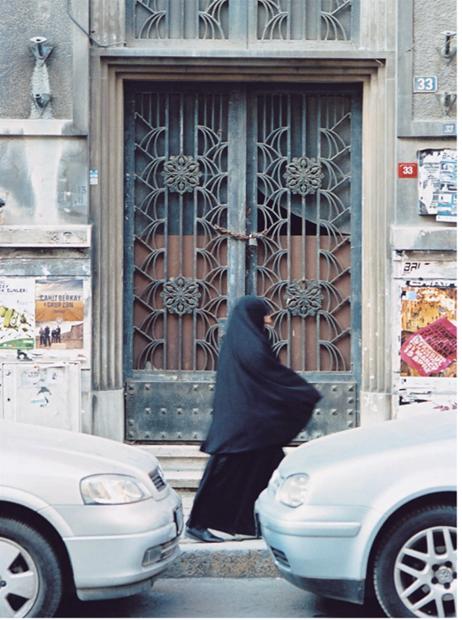
Although geographically in the West, it is in the old city where you most feel you are in the Orient – in Constantinople.
All of a sudden the traffic thickened and slowed. We were hemmed in by a queue of honking lorries, crossing the Bo aziçi Bridge over the fast-running waters of the Bosphorus Strait. The traffic ground to a halt; and for a few magical moments we found ourselves suspended in limbo between Asia and Europe.
aziçi Bridge over the fast-running waters of the Bosphorus Strait. The traffic ground to a halt; and for a few magical moments we found ourselves suspended in limbo between Asia and Europe.

It was the perfect vantage point to appreciate fully the vast and expanding metropolis of modern Istanbul, which swept before us along the European shoreline of the Bosphorus. Gazing out to the north-east we saw massive tanker ships ploughing through the choppy waters towards the Black Sea. And to the south-west, spread out in the distance like a dream, was the famous Istanbul skyline. Our hearts quickened and we wound down the windows to make out more clearly the cascading domes of the city’s great mosques, with their delicate spires and minarets glinting in the weak afternoon sunshine of late winter.
This was where we were heading: to Sultanahmet, the old imperial city, with its palace and mosques, its steamy bath-houses and ancient bazaars. Although geographically in the West, it is in the old city where you most feel you are in the Orient – in Constantinople.
For more than a thousand years Constantinople was the glorious capital of Byzantine Christendom, and a glittering beacon of sophistication for western Europe, mired as it was in the Dark Ages. And then, for the next few hundred years, Constantinople rose to even dizzier heights as the capital of the Turkic Ottoman Empire, the most powerful force in Europe and Asia.
For our first few nights in Turkey we were staying in Sultanahmet, where the steep narrow streets bristle with reminders of this great and glorious past. Our hotel was in the shadow of the graceful domes and six elegant minarets of the Blue Mosque and after settling ourselves into our rooms we wandered out to explore the neighbourhood.
Rain clouds were gathering overhead and the streets were deserted. A solitary simit seller trudged through the drizzle, weighed down by a tray of sesame-encrusted bread rings. We made our way towards the Hippodrome – or Sultanahmet Square as it is known today – which was empty apart from a handful of elderly men in raincoats, who sat on park benches sharing a bag of hot roasted chestnuts. It was hard to imagine that this was once an ancient racetrack, where rival chariot teams raced around to the cheers of a 120,000-capacity crowd.
We were ready for lunch, but before feeding our baser appetites we felt bound to satisfy our souls. Just beyond the northern end of the Hippodrome stands the jaw-droppingly lovely Haghia Sophia, Istanbul’s most famous monument. Built by the Emperor Justinian in the sixth century it was the greatest church in Christendom for nearly a thousand years and to this day is still thought by many to be the most beautiful church ever built.
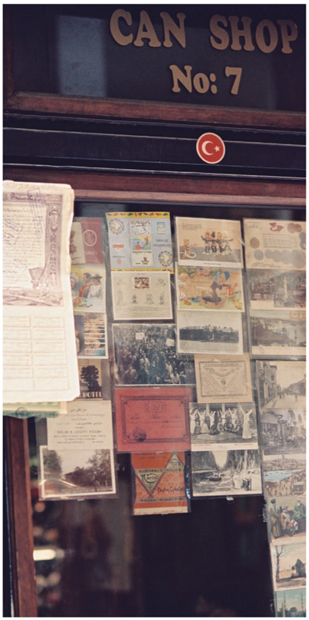
Converted to a mosque after the fall of Constantinople to the Turks in 1453, Haghia Sophia now boasts fountains and minarets, but the power of its vast soaring interior, the brilliance of its glittering mosaics and the sense of awe that it inspires has been undiminished – even by the scaffolding (courtesy of UNESCO-funded restoration work) that rose skywards into the dome.
And so on to lunch; something quick and easy, we were all agreed. The surrounding streets were lined with grotty-looking tourist restaurants and hazir yemek, the Turkish version of self-service, cheap-and-cheerful caffs. But Greg had other ideas. ‘We need to find a pideci,’ he announced. ‘I’ve got to have a lahmacun.’ No surprises there! Lahmacun – the Turkish equivalent of his favourite Lebanese lunch, lahme bi-ajeen, is the Eastern version of lamb-topped pizza. The best pide restaurants have wood-fired ovens and will usually offer a limited range of other options — kebabs and soups — as well.
By chance, we happened upon a wonderful Black Sea-style pide restaurant in a street tucked away between the Sultanahmet tramline and the Grand Bazaar. There were simple soups and salads, and in front of a large wood-fired oven two young men were working briskly in tandem, rolling and stretching out dough, forming the traditional long boat shapes, adding a variety of toppings and thrusting the pide into the deep glowing recesses. The smell was intoxicating and we eagerly gave our order.

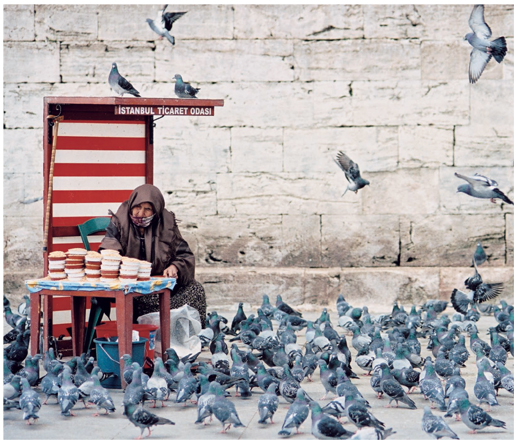
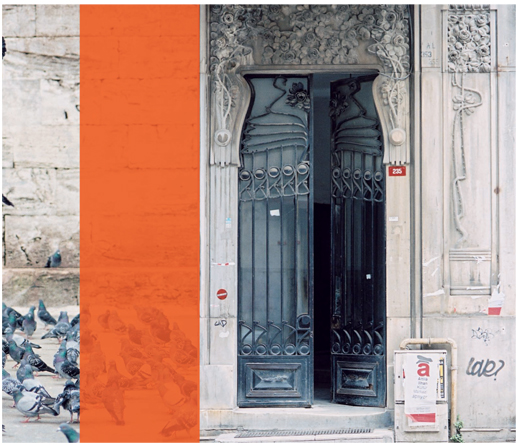

A few minutes later the food started arriving: two golden puffs of nigella-flecked bread emerged from the oven and landed in front of us with a trio of accompaniments. There was a dish of spicy red pepper paste, creamy whorls of butter and tangy white cheese. Next came deep bowls of steaming red soup – a popular Turkish ‘peasant’ dish that was thick with lentils, enlivened with a spritz of lemon and a sprinkling of dried mint. We scooped and dunked and sipped greedily, and then the main event arrived. There was Greg’s lahmacun, a crisp dough base smeared with spicy lamb paste and sprinkled with hot red pepper flakes. The pide were long and skinny, with the edges rolled in to contain the generous toppings: egg and spicy sucuk sausage and melting soft white cheese.
There may not have been swooning Imams, or delighted Sultans, but we all agreed, for a simple soup and sandwich lunch, and our first meal in Turkey, things just don’t get much better than that!
Hot yoghurt soup with chicken threads and corn
Versions of creamy hot yoghurt soup can be found across Turkey, and it’s thought to have originated with the nomadic herdsmen that settled in Anatolia a thousand years ago. At its simplest, it is flavoured with dried mint and may be thickened with rice, chickpeas, bulgur or barley. For this recipe I add sweetcorn kernels and threads of chicken to make it more substantial.
1 large chicken breast on the bone
1 small onion, cut into quarters
1 stick celery
½ lemon
1 sprig thyme
2 bay leaves
1 small stick cinnamon
½ teaspoon white peppercorns
1.5 litres Chicken Stock
100 g short-grain rice
½ cup sweetcorn kernels
500 g thick natural yoghurt
2 teaspoons cornflour
60 ml water
1 egg, lightly beaten
sea salt
freshly ground black pepper
40 g unsalted butter
1 tablespoon dried mint
dried red pepper flakes to serve (optional)
Put the chicken, vegetables, lemon, herbs, cinnamon, peppercorns and stock into a large, heavy-based saucepan. Bring to the boil, skimming away any fat and impurities that rise to the surface, then lower the heat immediately. Simmer very gently, covered, for 5 minutes. Turn off the heat and leave the chicken in the stock for 20 minutes.
Pull the chicken meat off the bone and shred it as finely as you can. Reserve for later. Strain the stock into a large, heavy-based saucepan, then add the rice and slowly bring to the boil. Simmer gently, covered, for 30 minutes until the rice has broken down and begun to thicken the soup. Add the corn kernels.
To stabilise the yoghurt, beat it in a large bowl until smooth. Mix the cornflour with the water, then stir it thoroughly into the yoghurt with the egg. Gently stir a spoonful of the hot soup into the yoghurt mixture, then pour this back into the barely simmering soup. Cook at a bare simmer for about 10 minutes, stirring in one direction only. Be sure not to let the soup boil or the liaison will curdle.
When ready to serve, add the shredded chicken to the soup and season with salt and pepper, then ladle the soup into warmed serving bowls. Quickly sizzle the butter in a small frying pan, then add the mint and heat until foaming. Swirl the sizzling butter into each bowl of soup, sprinkle with red pepper flakes, if using, and serve.
SERVES 6–8
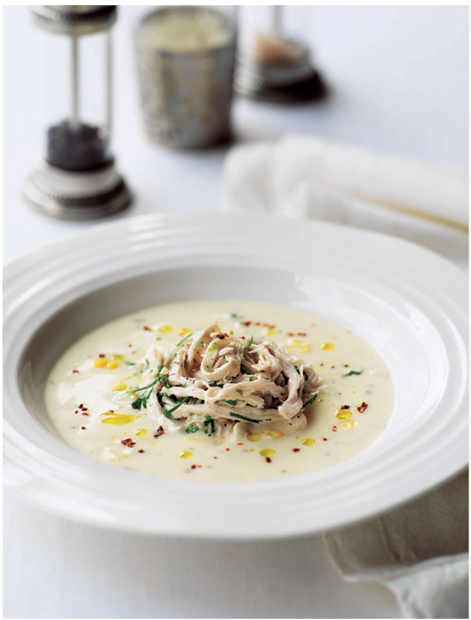
Chicken and vermicelli soup with egg and lemon
This is a Turkish version of everyone’s favourite chicken noodle soup, but instead of being a clear broth, the soup is rich and creamy. The ‘body’ is created by using grated onion; the soup is then finished with an egg and lemon liaison, which thickens it further, makes it velvety-smooth and adds a vibrant lemon flavour.
It’s essential to use a really good homemade chicken stock for this soup, such as the one (alternatively, use your own recipe or a top-quality stock purchased from a deli). With good stock to hand, this soup can be pulled together in a matter of minutes. (Please don’t be tempted to use stock cubes, though!)
1 small purple onion, peeled and coarsely grated
60 ml olive oil
20 g unsalted butter
1 long green chilli, seeded and finely shredded
50 g vermicelli noodles
800 ml Chicken Stock
250 g chicken breast, skin removed
3 egg yolks
juice of ½ lemon
½ teaspoon hot paprika
sea salt
freshly ground white pepper
 cup shredded flat-leaf parsley leaves
cup shredded flat-leaf parsley leaves
To make the soup, place the onion in a sieve. Press lightly with the back of a spoon and leave to drain for 5 minutes or so, discarding the juice.
Heat the oil and butter in a large, heavy-based saucepan, then sauté the onion over a low heat for 3 minutes. Add the chilli and sauté for another minute. Roughly break up the vermicelli noodles and add them to the pan with the chicken stock and simmer gently for 10 minutes. Cut the chicken breast into 5 mm dice and add to the pan, stirring gently over a very low heat for a minute.
In a small mixing bowl, whisk the egg yolks with the lemon juice. Ladle a spoonful of the hot soup into the egg mixture and whisk gently. Pour this back into the barely simmering soup, whisking continuously. Cook at a bare simmer, whisking gently, until the soup starts to thicken. Be sure not to let the soup boil or the liaison will curdle.
When the soup has thickened, add the paprika and season generously with salt and pepper. Stir in the parsley, then ladle the soup into warmed bowls and serve with hot buttered toast.
SERVES 6
Spicy lamb soup with lemon peel and rice
This soup combines all my favourite flavours: the sweet pungency of cinnamon and cumin, a mild chilli heat and a subtle underlying lemony tang. The addition of rice makes it feel particularly comforting, too. In my view, it’s the perfect soup!
60 ml olive oil
1 onion, diced
2 cloves garlic, finely chopped
1 teaspoon ground cumin
½ teaspoon hot paprika
½ teaspoon black peppercorns, lightly crushed
5 sprigs thyme
1 long red pepper, seeded and diced
1 long red chilli, seeded and diced
300 g lamb shoulder, cut into 1 cm cubes
1 stick cinnamon
1 bay leaf
long strip of peel from ½ lemon
1 litre Chicken Stock
 cup short-grain rice
cup short-grain rice
Heat the oil in a large, heavy-based saucepan. Sauté the onion and garlic for a minute, then add the spices, thyme, red pepper and chilli. Sauté over a low heat for another 5 minutes, until the vegetables soften.
Stir in the lamb until coated with the spiced onion mixture. Add the cinnamon stick, bay leaf, lemon peel and stock. Bring to the boil, skimming away any fat and impurities that rise to the surface, then lower the heat immediately. Simmer very gently, covered, for 45 minutes, or until the meat is tender. Skim from time to time. Add the rice to the pan and cook for another 15 minutes.
When ready to serve, ladle the soup into warmed bowls.
SERVES 6–8
Beyran soup – slow-cooked lamb soup with garlic and green chillies
This hearty soup comes from Gaziantep in the south-east of Turkey, where it’s eaten as a warming breakfast dish – especially during the long cold winters. Beyran is served in soup restaurants known as metanet lokantasi, which translates as building strength of body as well as spirit.
It requires a fair amount of strength and spirit to eat a traditionally made beyran as it includes sheep’s cheek and the solid tail fat from the fat-tailed sheep found all around the Middle East. (This solid white fat is the cooking medium of choice in the eastern and southern parts of the country, but it is rather terrifying to Western palates.) An authentic beyran is also full of garlic, and you’ll probably be offered a couple of sweet and spicy cloves to munch on as a breath-freshener as you head off to join the world again. Our tamed-down version uses lamb shanks, which provide a similarly melting texture without the fat. For the truer Gaziantep experience, add the extra garlic clove at the last minute.
3 lamb shanks
1 whole head of garlic, cut crosswise
1 onion, cut into quarters
1 carrot, cut into quarters
2 bay leaves
2 litres water
150 g short-grain rice
1½ teaspoons extra-virgin olive oil
additional 1 clove garlic, roughly smashed (optional)
chilli flakes to serve
lemon wedges to serve
long green chillies to serve
Put the lamb shanks, garlic, onion, carrot, bay leaves and water into a large, heavy-based saucepan. Slowly bring to the boil, skimming away any fat and impurities that rise to the surface, then immediately lower the heat. Simmer very gently, covered, for 1½ hours, skimming from time to time. Check after an hour and top up with more water if necessary.
Remove the pan from the heat, then carefully ladle the stock into a container, discarding the solids but reserving the lamb shanks. (Don’t be tempted to tip everything into a sieve: the less you disturb the solids at this stage, the clearer the final broth will be. I find the best method is to use a sieve to keep the solids submerged while you ladle out the liquid.)
Rinse the rice thoroughly under cold running water. Bring to the boil with 300 ml reserved lamb stock in a small saucepan, then lower the heat and drizzle in ½ teaspoon of the extra-virgin olive oil. Simmer gently, covered, for 15 minutes or until the rice is tender.
While the rice is cooking, remove the meat from the lamb shanks and tear it into small shreds. Bring the remaining stock, the shredded lamb, smashed garlic clove, if using, and remaining extra-virgin olive oil to a gentle simmer.
When ready to serve, place a spoonful of rice in the centre of each warmed bowl and distribute the shredded lamb evenly between them. Pour on the hot stock, then sprinkle the soup with chilli flakes and serve with lemon wedges, long green chillies and plenty of soft Turkish bread alongside. Squeeze on the lemon, then crunch on the chillies and chew on the bread as you slurp up the soup!
SERVES 6–8
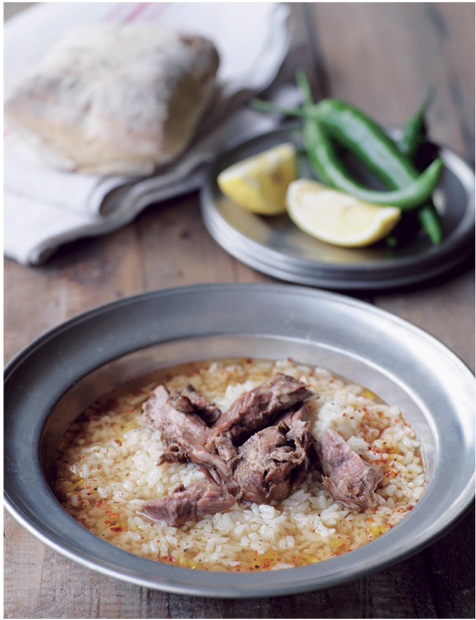
Red lentil ‘peasant’ soup with sizzling mint butter
Although essentially a home-style dish, versions of this hearty soup can be found in restaurants all around Turkey. The lentils break down during cooking, so the soup becomes almost creamy in the mouth. I like to add fine bulgur wheat towards the end of the cooking time, which adds a pleasing texture and makes the soup even more of a hearty winter warmer. The flavour is further enhanced by adding a drizzle of paprika-and mint-infused butter just before serving.
The soup thickens as it cools, so if you plan to reheat it, you may need to thin it with a little extra stock. Serve with warm Turkish bread.
2 tablespoons olive oil
1 large onion, finely diced
1 carrot, finely diced
2 cloves garlic, finely chopped
1 teaspoon ground cumin
1 teaspoon hot paprika
1½ teaspoons sweet paprika
1 tablespoon tomato paste
200 g red lentils
1.5 litres Chicken Stock
¼ cup fine bulgur
1 vine-ripened tomato, cut into quarters and seeded
sea salt
freshly ground black pepper
40 g unsalted butter
½ teaspoon dried mint
lemon wedges to serve
Heat the oil over a low heat in a large, heavy-based saucepan. Stir the onion, carrot and garlic around in the hot oil, then add the cumin, hot paprika and 1 teaspoon of the sweet paprika and sauté for 5–8 minutes, until the vegetables soften.
Stir in the tomato paste and cook for a minute. Add the lentils and chicken stock and bring to the boil. Cover the pan and cook over a medium heat for 20 minutes, stirring from time to time.
When the lentils have broken down and become creamy, add the bulgur. Dice the tomato finely, then add to the pan, season with salt and pepper and simmer for 10 minutes.
When ready to serve, ladle the soup into warmed serving bowls. Quickly heat the butter in a small frying pan until it foams, then add the remaining sweet paprika and the dried mint. Swirl the sizzling butter into each bowl of soup and serve with wedges of lemon.
SERVES 6–8
Silverbeet soup with chickpeas and barley
This soup was inspired by a dish we ate at the Müzedechanga restaurant at Istanbul’s Sabanci Museum. We’d just visited a fascinating exhibition about Ghengis Khan and ate lunch in the sunshine looking out over the beautiful museum gardens, with the Bosphorus in the distance.
The soup was full of silverbeet and chickpeas – just the sort of earthy flavours I love – and the pearl barley gave it a lovely chewiness. Even though it’s not really Turkish, I can’t resist serving this soup with a dollop of yoghurt.
160 g dried chickpeas
2 tablespoons olive oil
1 small onion, finely diced
3 sticks celery, finely diced
2 cloves garlic, finely chopped
½ teaspoon ground allspice
½ teaspoon ground cinnamon
5 sprigs thyme
220 g silverbeet leaves (stems removed), shredded
100 g pearl barley
1.5 litres Chicken Stock
2 bay leaves
1 long red chilli, seeded and shredded
½ vine-ripened tomato, seeded and diced
sea salt
freshly ground black pepper
lemon juice to serve
thick natural yoghurt to serve
Soak the chickpeas overnight in plenty of cold water.
Heat the oil in a large, heavy-based saucepan. Sauté the onion, celery and garlic over a low heat for 5–8 minutes, until the vegetables soften. Add the spices, thyme and silverbeet, then toss everything around in the pan for a few moments.
Drain and rinse the chickpeas and add them to the pan with the pearl barley, stock and bay leaves. Bring to the boil, then lower the heat and simmer, covered, for around an hour or until the chickpeas and barley are tender.
Add the chilli and tomato and season generously with salt and pepper. When ready to serve, remove the bay leaves and the thyme stalks. Ladle the hot soup into warmed bowls, then add a squeeze of lemon juice and a generous spoonful of yoghurt to each.
SERVES 6–8
Soups
In Turkey soups are eaten all day long – from early-morning breakfasts through to late-night snacks. They are a key part of any festive banquet, and are generally the first food to soothe a hungry stomach at the end of Ramadan fasting days. In winter, soups are the comfort-food par excellence, and the cure for all ills – even hangovers! Soups are not considered as just the opening act to Turkish meals, more often than not they will be the star turn.
In fact, there are entire restaurants, known as çorbaci (from çorba, the Turkish word for soup) that serve nothing but soup – some even specialise in a particular kind of soup. The most famous of these are probably i kembeci (tripe soup restaurants), which often stay open until the early hours of the morning serving up their potent hangover cure to those who’ve overdone the raki. It’s hard to know whether it’s the tripe that works the sobering-up magic, or whether it’s the traditional, fierce accompaniments of garlic, vinegar and chillies.
kembeci (tripe soup restaurants), which often stay open until the early hours of the morning serving up their potent hangover cure to those who’ve overdone the raki. It’s hard to know whether it’s the tripe that works the sobering-up magic, or whether it’s the traditional, fierce accompaniments of garlic, vinegar and chillies.
One of the most enjoyable meals we had on our Turkish journey was in the south-eastern city of Gaziantep, where we ate a fortifying soup called beyran. Although delicious, beyran is a fairly challenging dish that many might want to eat only a few times a year. Made from the sheep’s cheek and enriched with a big blob of solid white fat from a special Middle Eastern breed of sheep, you can almost feel your arteries hardening as you slurp it down.
The range of soups on offer is vast. There are simple vegetable soups thickened with a handful of rice, pasta or pulses, others are made from any part of the animal – from the head to the tail. A whole subsection of soups are yoghurt based, some contain green vegetables, like spinach, and others serve as the liquid vehicle for tiny rolled dumplings or stuffed manti. One of the best-loved soups is tarhana, which is a soup base made from a sun-dried, fermented mixture of bulgur wheat and yoghurt. A sort of precursor to Cup-a-Soup!
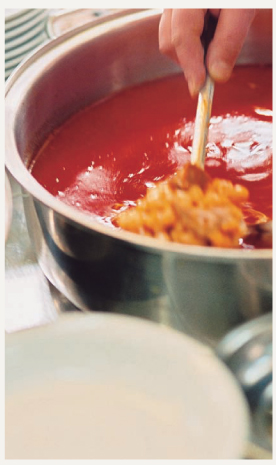
The one thing that all Turkish soups have in common, from the humblest Black Sea milk soup to the most elegant banquet soup, is the way they make so much out of very little. Above all, they are nourishing and economical and the mainstay of most home cooking.
Red pepper soup with bulgur, chickpeas, mint and chilli
A hearty soup chock-full of grains and pulses, this makes a lovely winter’s lunch with some crusty bread and a light salad.
Pekmez, or grape molasses, is available from Turkish food stores.
200 g dried chickpeas
60 ml olive oil
1 onion, finely diced
1 long red pepper, seeded and finely chopped
1 long red chilli, seeded and finely chopped
1 teaspoon dried mint
1 tablespoon pekmez
400 g can chopped tomatoes
1.5 litres water or vegetable stock
80 g coarse bulgur
 cup shredded mint leaves
cup shredded mint leaves
¼ teaspoon hot paprika
juice of ½ lemon
Soak the chickpeas overnight in plenty of cold water.
Heat the oil in a large, heavy-based saucepan. Sauté the onion, pepper, chilli and mint over a low heat for 5–8 minutes, until the vegetables soften. Add the pekmez and sauté for a further minute.
Drain and rinse the chickpeas and add them to the pan with the tomatoes and 1 litre of the water or stock. Bring to the boil, then lower the heat and simmer, covered, for around 30 minutes. Add the bulgur to the pan with the remaining liquid and simmer, covered, for a further 10 minutes, stirring from time to time.
When ready to serve, stir in the shredded mint, paprika and lemon juice. Ladle the soup into warmed bowls and serve piping hot.
SERVES 6–8
Pumpkin soup with a yoghurt swirl
A touch of cardamom and chilli lifts this soup into a rather exotic realm and the spices are beautifully counterbalanced by the creamy, sweet yoghurt swirl.
Pekmez, or grape molasses, is available from Turkish food stores.
2 tablespoons olive oil
20 g unsalted butter
2 leeks, white part only, roughly chopped
3 cloves garlic, roughly chopped
½ teaspoon ground cinnamon
¼ teaspoon ground cardamom
½ teaspoon freshly ground black pepper
3 teaspoons pekmez
1 small butternut pumpkin (about 800 g), peeled and diced
1 long red chilli, seeded and roughly chopped
1 bay leaf
1.25 litres Chicken Stock
YOGHURT SWIRL
200 g thick natural yoghurt
1 teaspoon pekmez
pinch of sea salt
Heat the oil and butter in a large, heavy-based saucepan. Sauté the leeks and garlic for a few minutes, then add the spices and sauté over a low heat for 5–8 minutes, until the leeks soften.
Stir in the pumpkin, chilli and bay leaf, then add the stock. Bring to the boil, skimming away any fat and impurities that rise to the surface, then lower the heat immediately. Simmer, covered, for 30 minutes.
Remove the pan from the heat and fish out the bay leaf. Purée the soup in batches in a vitamiser or with a hand-held blender until very smooth and creamy. If you want it to be supremely silky-smooth, pass the soup through a fine sieve.
Beat the yoghurt with the pekmez and salt in a small bowl until smooth. When ready to serve, ladle the soup into warmed bowls and swirl in a generous dollop of yoghurt.
SERVES 4–6
Fresh tomato and orzo soup with gruyère croutons
We were fascinated to discover a type of gruyère from Kas in the far east of Turkey.
Its sweet nutty flavour complements the sweetness of the soup beautifully.
2 tablespoons olive oil
1 teaspoon unsalted butter
1 shallot, finely diced
½ teaspoon honey
1 heaped teaspoon tomato paste
8 large vine-ripened tomatoes, skinned, seeded and roughly chopped
1 bay leaf
 cup orzo pasta, cooked
cup orzo pasta, cooked
1 litre Chicken Stock
1 tablespoon lemon juice
2 tablespoons shredded flat-leaf parsley leaves
GRUYèRE CROUTONS
6 slices day-old baguette, cut on the diagonal
½ clove garlic
120 g gruyère, grated
sweet paprika for dusting
Heat the oil and butter in a large, heavy-based saucepan. Sauté the shallot for a few minutes until soft and translucent, then add the honey and tomato paste and cook for a few more minutes. Add the tomatoes, bay leaf, orzo pasta and stock. Bring to the boil slowly, skimming away any fat and impurities that rise to the surface, then lower the heat immediately. Simmer very gently, covered, for 20 minutes, skimming from time to time.
To make the gruyère croutons, preheat your grill to its highest setting. Toast the baguette on one side, then rub the untoasted side with garlic and top with gruyère. Grill until golden and bubbling, then dust lightly with paprika.
When ready to serve, stir the lemon juice and parsley into the soup. Ladle the soup into warmed bowls over the cooked orzo pasta and float the hot gruyère croutons on top.
SERVES 6–8
Fish soup with young fennel and raki
Raki is the national drink of Turkey and its anise flavour brings out the fennel in this seafood soup brilliantly. Serve with plenty of hot crusty bread.
If you are unable to find raki, substitute arak, ouzo or Pernod.
2 tablespoons olive oil
1 onion, finely chopped
1 leek, white part only, finely chopped
1 clove garlic, finely chopped
2 small bulbs fennel, cored and sliced lengthwise
2 long red chillies, split lengthwise and seeded
2½ tablespoons Seafood Spice Mix
1.5 litres Crab Stock
1 teaspoon sea salt
16 mussels, scrubbed and bearded
4 red mullet, filleted
2 small calamari, cleaned
200 g cooked chickpeas
2 ripe tomatoes, seeded and diced
1 generous tablespoon raki
60 g raw prawn meat
extra-virgin olive oil to serve
flat-leaf parsley leaves, finely shredded, to serve
Heat the oil in a large, heavy-based saucepan or an enamelled pot and add the onion, leek, garlic, fennel and chillies. Add the spice mix, reserving a teaspoon. Sauté over a medium heat for a couple of minutes, stirring to coat the vegetables with the spices. Add the stock and season with salt. Simmer gently, uncovered, for about 20 minutes, or until the vegetables are very tender. Skim from time to time.
Meanwhile, discard any mussels that refuse to open after a sharp tap. Check the fish fillets for any lingering pin bones. Cut the calamari tentacles into short lengths. Split the tubes lengthwise and score the inside of each in a criss-cross pattern, then cut into quarters.
Lightly dust the fish and calamari with the remaining spice mix. Add the chickpeas and tomatoes to the pan and splash in the raki. Add the mussels, prawns, fish fillets and calamari, then increase the heat and cook, covered, for 3–4 minutes until the mussels begin to open.
Serve immediately from the pan at the table, distributing the seafood, vegetables and broth between warmed bowls. Add a drizzle of extra-virgin olive oil and a little parsley to each bowl.
SERVES 8
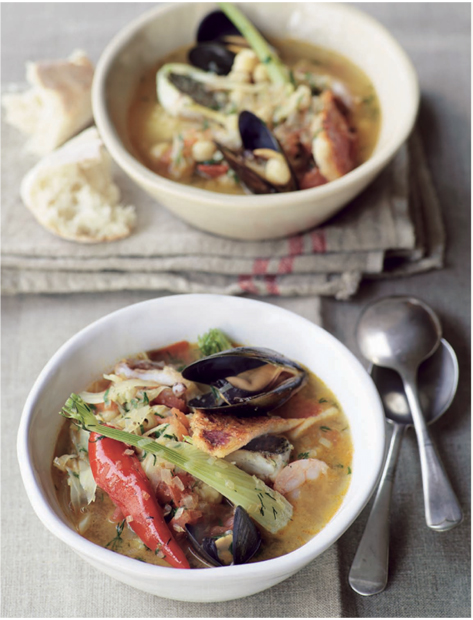
Golden avgolemono with prawns, chicory and rice
Egg and lemon sauces and soups are a distinctive component of both Turkish and Greek cookery. Using eggs to add richness was a common feature of medieval cookery, and the egg–lemon combination is believed to have been a Byzantine idea, taken up by the sophisticated kitchens of the Ottoman sultans.
The appeal of avgolemono (as they are known in Greek) or terbiye (Turkish) sauces and soups is that they are rich and velvety-smooth, with a refreshing lemony flavour.
1.2 litres Crab Stock (opposite)
150 g short-grain rice
½ teaspoon freshly ground black pepper
4 egg yolks
juice of 2 small lemons
1 cup shredded chicory leaves
1 tablespoon finely chopped dill
1 teaspoon dried mint
240 g raw prawn meat
40 g unsalted butter
good pinch of sweet paprika
Heat the stock in a large, heavy-based saucepan, then add the rice and pepper and bring to the boil. Lower the heat and simmer, uncovered, for 20 minutes.
In a small mixing bowl, whisk the egg yolks with the lemon juice. Ladle a spoonful of the hot stock into the egg mixture and whisk gently. Pour this back into the barely simmering soup, whisking continuously. Cook at a bare simmer, whisking gently, until the soup starts to thicken. Be sure not to let the soup boil or the liaison will curdle.
Add the chicory, dill, dried mint and prawn meat to the pan and simmer gently for 3 minutes, or until the prawns are barely cooked. Meanwhile, quickly heat the butter in a small frying pan until it foams, then add the paprika. When ready to serve, ladle the soup into warmed serving bowls and swirl on the sizzling butter.
SERVES 8
Crab stock
A wonderful, fragrant stock I like to use for all sorts of seafood soups, stews and braises, instead of the more prosaic fish stock. It should be used within 24 hours of being made, or it can be frozen for up to 3 months.
2 kg crabs
150 ml olive oil
4 sticks celery, roughly chopped
2 onions, roughly chopped
4 cloves garlic, roughly chopped
½ teaspoon fennel seeds, roughly crushed
400 g can diced tomatoes
125 ml sherry
long piece of peel from 1 orange
20 strands saffron, roasted and crushed
2 bay leaves
12 sprigs thyme
4 litres water
Remove the underbody from the crabs and pull away the spongy gills (‘dead man’s fingers’). Cut each body in half and bash the shells and claws into large pieces.
Heat the oil in a large, heavy-based saucepan to smoking point. Sauté the crab pieces briefly over a high heat, then add the celery, onion, garlic and fennel seeds and sauté for 2 minutes. Stir in the tomatoes, sherry, peel, saffron, bay leaves and thyme, then add the water. Bring to the boil, skimming away any fat and impurities that rise to the surface, then lower the heat immediately. Simmer, uncovered, for an hour, skimming from time to time.
Carefully ladle the stock into a container, discarding the solids. (Don’t be tempted to tip everything into a sieve: the less you disturb the solids at this stage, the clearer the final broth will be. I find the best method is to use a sieve to keep the solids submerged while you ladle out the liquid.) Refrigerate or freeze for later use.
MAKES 2.5 litres
Chicken stock
You can use this stock as a base for any recipe that calls for chicken stock. The quantities given here are enough to make around 2.5 litres, and the stock can be frozen quite happily for up to 3 months.
3 kg chicken carcasses
1 onion, cut into quarters
2 sticks celery, roughly chopped
1 leek, white part only, roughly chopped
2 cloves garlic, halved
½ teaspoon black peppercorns
1 bay leaf
3 sprigs thyme
Rinse the chicken carcasses and then put them into a 5-litre stockpot. Pour on enough water to cover the bones generously and add the remaining ingredients. Bring to the boil, skimming away any fat and impurities that rise to the surface, then lower the heat immediately. Cover the pot and simmer very gently for 2 hours, skimming from time to time.
Carefully ladle the stock into a container, discarding the solids. (Don’t be tempted to tip everything into a sieve: the less you disturb the solids at this stage, the clearer the final broth will be. I find the best method is to use a sieve to keep the solids submerged while you ladle out the liquid.)
Refrigerate for up to three days or freeze for later use.
MAKES 2.5 litres